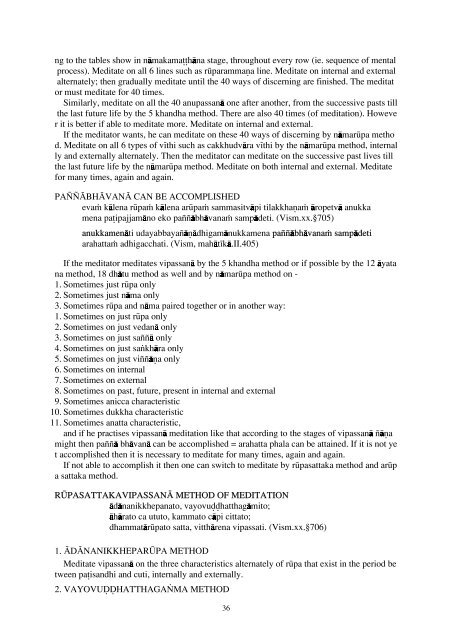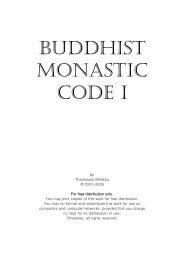Vipassana Kammatthana.pdf
Vipassana Kammatthana.pdf
Vipassana Kammatthana.pdf
Create successful ePaper yourself
Turn your PDF publications into a flip-book with our unique Google optimized e-Paper software.
ng to the tables show in nåmakama håna stage, throughout every row (ie. sequence of mental<br />
process). Meditate on all 6 lines such as rËparammaˆa line. Meditate on internal and external<br />
alternately; then gradually meditate until the 40 ways of discerning are finished. The meditat<br />
or must meditate for 40 times.<br />
Similarly, meditate on all the 40 anupassanå one after another, from the successive pasts till<br />
the last future life by the 5 khandha method. There are also 40 times (of meditation). Howeve<br />
r it is better if able to meditate more. Meditate on internal and external.<br />
If the meditator wants, he can meditate on these 40 ways of discerning by nåmarËpa metho<br />
d. Meditate on all 6 types of v¥thi such as cakkhudvåra v¥thi by the nåmarËpa method, internal<br />
ly and externally alternately. Then the meditator can meditate on the successive past lives till<br />
the last future life by the nåmarËpa method. Meditate on both internal and external. Meditate<br />
for many times, again and again.<br />
PAÑÑÓBHÓVANÓ CAN BE ACCOMPLISHED<br />
eva◊ kålena rËpa◊ kålena arËpa◊ sammasitvåpi tilakkhaˆa◊ åropetvå anukka<br />
mena pa ipajjamåno eko paññåbhåvana◊ sampådeti. (Vism.xx.§705)<br />
anukkamenåti udayabbayañåˆådhigamånukkamena paññåbhåvana◊ sampådeti<br />
arahatta◊ adhigacchati. (Vism, mahåt¥kå.II.405)<br />
If the meditator meditates vipassanå by the 5 khandha method or if possible by the 12 åyata<br />
na method, 18 dhåtu method as well and by nåmarËpa method on -<br />
1. Sometimes just rËpa only<br />
2. Sometimes just nåma only<br />
3. Sometimes rËpa and nåma paired together or in another way:<br />
1. Sometimes on just rËpa only<br />
2. Sometimes on just vedanå only<br />
3. Sometimes on just saññå only<br />
4. Sometimes on just sa∫khåra only<br />
5. Sometimes on just viññåˆa only<br />
6. Sometimes on internal<br />
7. Sometimes on external<br />
8. Sometimes on past, future, present in internal and external<br />
9. Sometimes anicca characteristic<br />
10. Sometimes dukkha characteristic<br />
11. Sometimes anatta characteristic,<br />
and if he practises vipassanå meditation like that according to the stages of vipassanå ñåˆa<br />
might then paññå bhåvanå can be accomplished = arahatta phala can be attained. If it is not ye<br />
t accomplished then it is necessary to meditate for many times, again and again.<br />
If not able to accomplish it then one can switch to meditate by rËpasattaka method and arËp<br />
a sattaka method.<br />
RÚPASATTAKAVIPASSANÓ METHOD OF MEDITATION<br />
ådånanikkhepanato, vayovu∂∂hatthagåmito;<br />
åhårato ca ututo, kammato cåpi cittato;<br />
dhammatårËpato satta, vitthårena vipassati. (Vism.xx.§706)<br />
1. ÓDÓNANIKKHEPARÚPA METHOD<br />
Meditate vipassanå on the three characteristics alternately of rËpa that exist in the period be<br />
tween pa isandhi and cuti, internally and externally.<br />
2. VAYOVUflflHATTHAGA‹MA METHOD<br />
36






